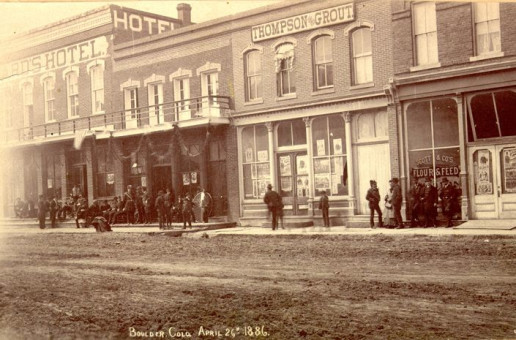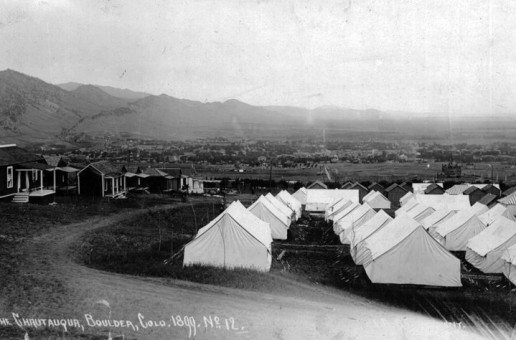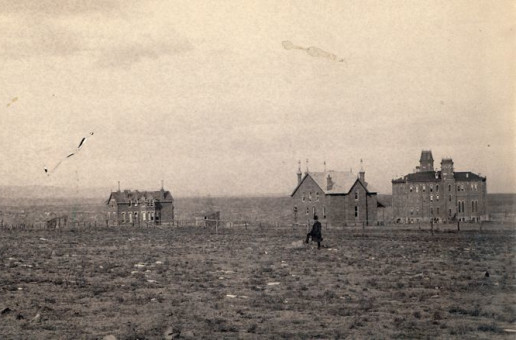Boulder History
Get to know Boulder on a whole new level when you delve into the past events, people and forces that came to shape the city we know and love today.
Visit Boulder acknowledges that the land on which we live, work and recreate today has been inhabited by Indigenous people for more than 13,000 years. We honor all Native nations associated with the Boulder Valley, affirm their ancestral ties to their homeland and acknowledge the history of mistreatment and forced removal that has had a devastating impact on their communities. When we discuss Boulder with visitors and our communities, we are discussing Native lands, and we endeavor to do our part to include the stories of the area’s first inhabitants.
In the mid-1800s, Boulder was filled with abundant wildlife including buffalo, antelope and elk. The valley served as the winter home and hunting grounds to nomadic bands of Indigenous people. The Arapaho, on the plains, and the Utes, in the mountains, are the two tribes most associated with Boulder’s recent past.
Boulder's Settlement
In the fall of 1858, a group of prospectors from Nebraska made their way to what is now called Boulder Creek. After finding gold in a stream near present-day Gold Hill in the mountains west of Boulder, they made their settlement permanent, breaking a promise to Chief Niwot and his band of Southern Arapahos who lived in what is now Boulder.
On February 10, 1859, the group of 60 prospectors established the Boulder City Town Company, named for the large number of boulders they found in nearby streams.
Never mind that the settlement was in violation of the 1851 Treaty of Fort Laramie, which granted the land to the Plains Indians, the town founders divided up the acres into 4,044 lots and priced them at $1,000 each. The price was much higher than in other towns like Denver, and the lots didn’t sell quickly.
News of gold discoveries near Denver and at Gold Run spread and led to the "Rush to the Rockies" in the spring of 1859. Some 100,000 prospectors, mostly men, set out for the Rocky Mountains hoping to make their fortunes.
Boulder grew slowly at first. In 1871, the fledgling city was incorporated as the Town of Boulder, with a population of just over 340 residents.

Gold Hill on July 4, 1886
Download our guide and walkable map of Boulder's historic districts, grab yourself a cup of coffee and head out for an adventure.
The Early Years
In the early years of Boulder City, mining played an extremely important role. It continued to bring settlers to the area who were both involved in mining itself and in supporting facilities, such as hardware and mining supply stores, transport businesses, room and board houses, and gambling and drinking establishments. Soon a strong agricultural industry, including grain milling, began to develop.
Small businesses were established up and down Pearl Street, Boulder’s main thoroughfare, supplying miners and their families with all of the goods needed for work and home. Downtown expanded for several blocks as the town grew and residential areas appeared in the Downtown, Mapleton Hill and Whittier subdivisions.
As Boulder grew, citizens made very intentional choices on what kind of community they wanted to cultivate. After all, "Boulder, the Place to Live," was an unofficial motto.

Pearl Street in 1886
Texans Form the Chautauqua
When the news came that Texas education officials were looking for a mountain spot for an educational teachers' retreat, Boulder officials put their hat in the ring with enthusiasm.
The Texans believed the Chautauqua platform, based on four pillars — education, cultural arts, religion and recreation — would be perfect for the retreat they envisioned. Their plan derived from the original Chautauqua, established in 1874. Named for Chautauqua Lake in upstate New York, the first Chautauqua was created by Methodist ministers for Sunday school teachers. The idea caught on and soon hundreds of Chautauquas were founded all over the country.
Boulder residents valued education and viewed a Chautauqua as a chance to bring significant learning opportunities as well as culture to the community. The Texas-Colorado Chautauqua opened on July 4, 1898, and the whole city celebrated.
Hundreds of teachers and families from Texas and other states traveled to the new Chautauqua to complete summer school classes, enjoy lectures and cultural performances, and take picnics and ‘tramps’ in the mountains. At first, accommodations were simple tents, but soon summer cottages were built.
In 1978, the Colorado Chautauqua was protected as a local historic district and named on the National Register of Historic Places. In 2006, it became Boulder County’s first and only National Historic Landmark. It is one of only a few Chautauquas that remain in operation today.

Chautauqua in its second year, with both cottages and tents
Boulder’s Early Black Community
Though Boulder was not segregated on the books, many Black residents lived in an area of town known as "The Little Rectangle." The Little Rectangle was roughly from 19th to 23rd Streets and Water Street (now Canyon Boulevard) to Goss Street.
In 1927, the City hired planner Saco DeBoer to develop zoning recommendations for the town. DeBoer suggested the city acquire land along Boulder Creek for parks and limit industries to the east of the city.
With industry pushed out of town, economic opportunities for Black residents decreased and many moved to Denver where the jobs were more plentiful. Boulder’s Black population reached a high of 166 residents in 1910 and declined for many decades afterward.
By the mid-1920s, the Ku Klux Klan controlled the state legislature and had significant influence in Boulder. A crossed burned on Flagstaff Mountain in 1924. By the end of the 1920s, the Klan’s years of influence in Colorado receded.
One of the most well-known Black residents in Boulder was Oliver Toussaint, ‘O T.’ Jackson, a restaurant entrepreneur and the governor’s special messenger. He opened Jackson’s Resort in 1897 and operated the Chautauqua Dining Hall during the first year of the Chautauqua. He and his black staff were later replaced by an all-white staff.
Learn more by attending a screening of This Is [Not] Who We Are, a documentary film exploring the gap between Boulder's progressive self-image and the lived experiences of its Black citizens.
A self-guided tour, downloadable from Pocket Guides, takes you through the Little Rectangle and beyond to explore Boulder's black community history.
Establishing the University
Residents knew they wanted a college located in Boulder, and from the earliest days advocated for the state university to be built here. Prominent citizens gave land to ensure the deal. Finally, the territorial legislature appropriated $15,000 for the construction in 1874, with the stipulation that there be a matching donation by the community. Boulder citizens met the challenge and raised about $17,000. Doors at Old Main opened for the first handful of students in 1877.

University of Colorado's Old Main (far right) in 1884
By 1900, Boulder’s population had reached more than 6,000 residents and the town was transitioning from mining supplies to a more sophisticated University community. To help their town grow into a quality city, Boulder citizens made careful choices.
Boulder residents and business owners agreed that they needed a first-class hotel. Citizens responded with enthusiasm by donating funds. They chose a unique name that guests would remember, Hotel Boulderado, combining both city and state, and the hotel opened for business on January 1, 1909.
Roots of Wellness
Boulder was one of many destinations in the American Southwest for people suffering from tuberculosis. At the time, the only recommended medical treatment for the ailment was a high, dry climate, and nutritious food.
In the 1890s, Dr. John Harvey Kellogg set up the Sanitarium Boarding Home on University Hill in 1893, run by the Seventh Day Adventists. The house was soon full to capacity and was replaced by the Boulder Colorado Sanitarium on Mapleton Hill in 1896.
The new sanitarium no longer catered to tuberculosis patients but instead became a full-fledged health resort offering the latest medical and alternative medicine treatments to care for mind, body and spirit. Good nutrition was key, and the sanitarium sold health foods like whole-grain bread and granola to patients and residents for decades, setting the stage for the natural healing and health-food movement that is today integral to the culture of Boulder.
Big Science Comes to Boulder
In the 1940s Boulder had developed into a pleasant college community, but there was concern that young people were leaving Boulder because of the lack of good jobs. So when the National Bureau of Standards needed a new location, the head of Boulder's Chamber of Commerce, Francis ‘Franny’ Reich, sold the government officials on the beauty of Boulder and its university and also boldly promised land for the project.
Citizens rallied for the cause. They raised $70,000 in eight days to purchase 217 acres of land to give to the U.S. government for the lab.
The was the first of several scientific laboratories and companies to locate in Boulder and change the character of the city forever. Beech Aircraft in 1955, Ball Brothers Research in 1956, IBM in 1965, the National Center for Atmospheric Research (NCAR) in 1967, and the National Oceanic and Atmospheric Administration (NOAA) in 1970 helped Boulder become recognized as a world-class center for space and atmospheric science.

National Bureau of Standards Groundbreaking Ceremony, 1951
Did you know that the United States atomic clock is from Boulder? NIST-F1, the nation's primary time and frequency standard, is a cesium fountain atomic clock developed at the National Institute of Standards and Technology laboratories in Boulder in the 1950s.
The Counterculture Movement
In the late 1960s, hippies, the anti-establishment youth of our nation, were leaving home and discovering places to congregate with like-minded peers. The CU campus was vibrant with student activism that addressed women’s rights, racial inequality and the Vietnam War with demonstrations and sit-ins. Combined with a burgeoning rock and roll music scene on University Hill, Boulder was a perfect place to attract hippies. They came in droves via hitchhiking and Volkswagen buses with long hair, blue jeans and an alternative outlook on life. Conservatives in Boulder called it an invasion.
Eventually, the "hips" and the "straights" found a way to coexist in Boulder. Many hippies stayed in town, starting alternative businesses like the Cotangent and Phantasmagoria for counterculture fashion, and Celestial Seasoning for teas.
The 1971 city election brought a "sea change" in Boulder politics. Penfield Tate II, an attorney with a handlebar mustache and trademark string of beads worn over a suit and tie, won the most votes and became Boulder’s first African American council member. (There's currently a vibrant mural honoring him on the side of the Boulder Public Library.) In January of 1974, Tate was chosen by his fellow council members as mayor, the first African American mayor in Boulder. He served as Boulder’s mayor from 1974-1976. Tate was ahead of his time. Remembered for his commitment to human rights, he was an early ally in the LGBTQ+ movement, while facing stark criticism for his positions.

Vietnam War Protesters Marching on the Streets of Boulder, Circa 1969
Tibetan Buddhism
Choygam Trungpa Rinpoche, exiled from his native Tibet in 1959, made his way to the United States in 1970. Rinpoche, meaning ‘precious one’ is an honorary title bestowed on Buddhist teachers. The University of Colorado was forming a religious studies department at the time. Trungpa was invited by a CU professor to teach in the new academic program.
Trungpa took to Boulder immediately. The Rocky Mountains reminded him of his native Himalayas. In 1974, he helped establish The Nalanda (giver of knowledge) Foundation, the organization that directs Naropa (an Indian Buddhist yogi) Institute, now Naropa University.
Within a short time, there were almost 1,000 Buddhists in Boulder. Nearly all were converts, as opposed to being born into the spiritual practice. Buddhist culture continues to grow and remains an important part of Boulder’s character today.
More to Explore
Pioneers in Land Preservation
In 1950, Boulder was a small college town with a population of 19,999. Between 1950 and 1970 Boulder’s population more than tripled to 66,870.
In the face of rapid growth, Boulder residents were determined to protect the beauty of their mountain backdrop.
In 1959 citizens gathered signatures for a ballot initiative known as the Blue Line. The Blue Line was an imaginary line, 5,750 feet west of Boulder. The measure stated that city water services would not be provided above the Blue Line, thereby discouraging housing developments in the mountains. The Blue Line Amendment to the City Charter passed overwhelmingly. After the successful election, some of the supporters formed PLAN-Boulder (People’s League for Action Now) in September of 1959, a group that has been influential in Boulder politics ever since.
Meanwhile, citizens were working on stopping a resort hotel and luxury home development above Chautauqua Park. In 1962 Boulder voters approved bonds for the City to purchase 155 mountain acres and preserve land known as the Enchanted Mesa.
In 1967, citizens, many from PLAN-Boulder, ran a grassroots Greenbelts for Boulder campaign. Voters made history as they passed the nation’s first municipal sales tax to purchase and preserve community open space.
Preserving the Mountain Views, Too
While many Boulder officials thought the only way to have a successful downtown was to build high rises, some citizens, again many from PLAN-Boulder, disagreed and led an effort to limit the height of new buildings to 55 feet, so as not to ruin mountain views. In 1971, the measure won, by a slim margin. Boulder’s downtown, with the Pearl Street pedestrian mall, is a success story without tall buildings.
In 1976, Paul Danish wrote a growth management plan, the Danish Plan, which was designed to limit growth to 1.5 to 2 percent for a five-year period. Businesspeople were appalled at the program, and the City Council rejected it. But citizens gathered signatures for the anti-growth measure, and with PLAN-Boulder’s support, and it narrowly passed.
Today Boulder faces some of the consequences of the choices to build a beautiful town with limited growth — namely the high cost of housing.
In 1967, Boulder voters made history when they became the first city to tax itself for the express purpose of purchasing and preserving community open space.
Modern Times
Today, Boulder has 104,175 residents, including 36,430 University of Colorado students.
Many things in Boulder have changed since its humble beginnings. But the themes that define Boulder today – health and wellness, education and culture, outdoor recreation, science and innovation – didn’t happen by chance.
Boulder’s thoughtful and visionary citizens have shaped the town’s development with a concerted effort to create a beautiful place to live, work and play.
More Ideas for You
Think You Know Boulder?
See if you've heard about these locals-only secrets
Amazing Women of Boulder
Badass women + where to walk in their footsteps in Boulder
Explore the Farm Trail
Farm fun including animal encounters, u-pick crops, farm stands and prime picnic spots








